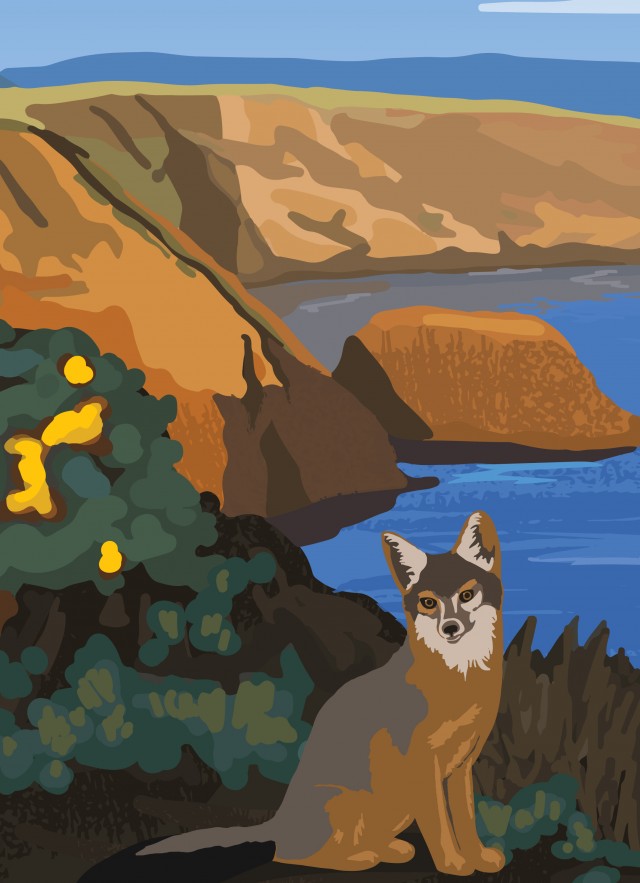NHM Journeys: California Channel Islands

NHM Journeys: California Channel Islands
August 15 - 18, 2019
The largest of the California Channel Islands, Santa Cruz Island is a fascinating world of nature and history that has long been the focus of important geological, ecological, and anthropological study. We explored the island's fascinating story firsthand, from its prehistoric origins and home of local indigenous people, through the Spanish colonial era and period as a ranch in the nineteenth century, to the herculean conservation efforts that have helped this natural paradise flourish and endure today.
Our base camp was the island's University of California, Santa Barbara Field Station. We enjoyed the rare privilege of calling the Field Station home for the four days we were on the island. This active research outpost regularly hosts an array of scientists conducting field work on the island. As we walked in their footsteps, we got to live just like the scientists do—but we enjoyed the added benefit of fully catered meals, which featured a menu curated by an expert chef to reflect the bounty of the regional environment. Accommodations were a mixture of private rooms and lodging in the main bunk room, with shared bathrooms and a comfortable common lounging and dining area.
Associate Curator of Anthropology, Dr. Amy Gusick, and Associate Curator of Herpetology, Dr. Greg Pauly, led us on day excursions exploring the beautiful island. From ancient archaeological sites that tell the story of the island’s indigenous people and the animals that have shaped and been shaped by this unique ecosystem, to the geologic forces that created the Channel Islands themselves, we traced the millennia-spanning story of this rare natural habitat.
Corinne Heyning Laverty is the author of the narrative non-fiction book North America's Galapagos: The Historic Channel Islands Biological Survey, which chronicles the Natural History Museum's groundbreaking expeditions to the islands in the late 1930s and early 1940s. Corinne immersed us in the historical account that highlights NHM's role in these unprecedented journeys. Participants also enjoyed a behind-the-scenes look at museum research past and present, and experienced the uniqueness of the Channel Islands' ecosystems.
Thursday, August 15, 2019
We sailed from Ventura Harbor at 8:30 a.m. for a one-hour voyage across the channel, with possible dolphin and whale sightings en route. Then we drove through the beautiful landscape of Santa Cruz Island to reach the UCSB Field Station. After getting settled and enjoying lunch, we explored the island's Chumash archaeology and the historic nineteenth century ranch, followed by an evening presentation by our researchers.
Friday, August 16, 2019
For an introduction to the amazing coastline of Santa Cruz Island, we traveled to the west end of the island to visit the historic Christy Ranch and nearby beach and valleys. While the destination is stunning, the drive out also provided sweeping views of the island from Ridge Road, which runs along one of the island's two mountain ridges. Along the way, we stopped at key locations to discuss the island's geology and environment, and the lives of its Chumash residents prior to European contact.
Saturday, August 17, 2019
On the last full day of our trip, we visited the east end of the island. The Isthmus separates the the middle and western regions owned by The Nature Conservancy from the National Park Service-owned eastern end. This unique area is home to the island's most spectacular geology, as well as the historic Del Norte ranch.
Sunday, August 18, 2019
Our departure from the island wasn't complete without an exploration of the Prisoner's Harbor area. The embarkation point for our trip back home, Prisoners Harbor is steeped in both indigenous and European history. The Chumash village of Xaxax is located here. It was also the site of historic development and landscape alterations completed by the Caire family in the late nineteenth century. Currently, the area is the site of extensive wetlands restoration efforts by the National Park Service. After our explorations, we boarded the 3:30 p.m. boat for an afternoon crossing to the mainland.
To find out more about this NHM Journey or learn about upcoming Fellows events, feel free to email the Fellows Office at fellows@nhm.org or call 213.763.3253.